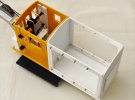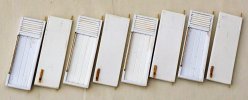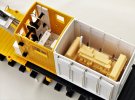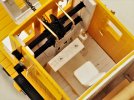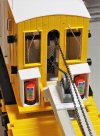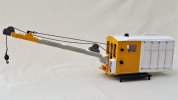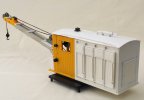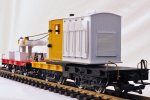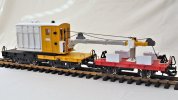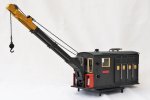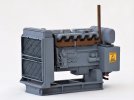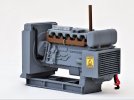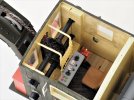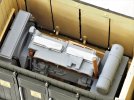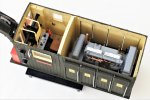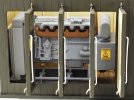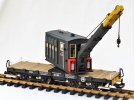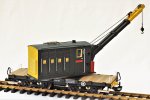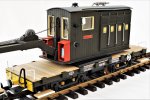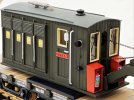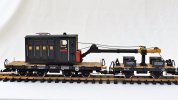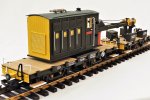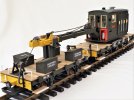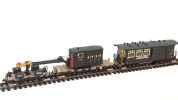David1226
Registered
Part 1 of 5
To add variety and interest to the Claptowte Railway rolling stock, I had always intended to add a travelling crane, with associated match truck, to support the crane jib while in transit. To that end, over the years, I had collected various donor vehicles and components to construct such vehicles. The crane is based on the LGB Toy Train crane, with an additional Toy Train stake wagon to increase the length of the frame and decking as it was my intention to mount it on a pair of bogies.
Some years ago I acquired a resin casting of a diesel generator, from a trade stand at an exhibition. I believe it to be a copy of a plastic model that was supplied as a wagon load (x3) on a USA Trains flatbed. I thought of using it to use as a wagon load myself until I had the idea of using it as the power source for the travelling crane. The casting itself, was not top quality, being full of blow holes, but used inside the bodywork of a crane, these faults would not be obvious, indeed, most of the time not seen at all.

This is the resin casting of the diesel generator.
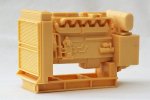
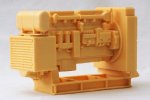
This is the starting point of the actual crane conversion, the LGB Toy Train crane body, removed from the stake wagon on which it comes mounted.

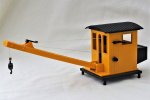
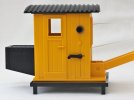

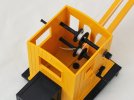
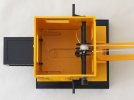
I actually began the conversion of this model with the underframe and decking. I took the Toy Train stake wagon on which the crane body had been mounted and added a second stake wagon. Both wagons were dismantled down to their basic components. The stakes, and the two wheel bogies and wheels, on which the wagons had run, were consigned to the spares box. Of the four brake pipes, two were put aside for use on the new body and the other two followed the wheels into the spares box.
In order to create a new longer single body, to mount onto bogies, I used a razor saw to cut midway between the 4th and 5th stake pockets on both bodies, so that when the bodies are brought together, the spacing between the stake pockets, along both sides, are maintained. Be sure to cut off the ‘non balcony’ ends, so that when the underframes are cut to length, to match the decking bodies, the fixing points for the footsteps are retained.
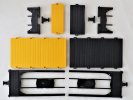
I cut the buffers from the short lengths cut from the underframes. The buffers were kept and consigned to the spares box, the offcuts of decking and frame were discarded.
The two shortened decks were then glued together with a butt joint. The underside of the join was reinforced using a section of 2.0mm plasticard.
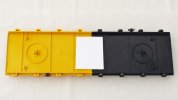
I took the underframes and cut off the ‘W’ irons and brake support.

I cut out the various tanks, retaining the large cylindrical tanks and discarding the rest.
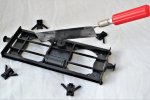
I then cleaned up the frames and tanks with files and wet or dry paper.
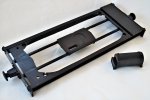
I then offered up each of the underframes to their respective bodies and cut these to match the body lengths. I glued the two haves together and used plastic strip to strengthen the joints.
Using various suitable thicknesses of plasticard, I built up the underside of the underframes to the appropriate height, finishing off with a large rubbing plate for the bogies. Holes were drilled into which plastic tube was glued to form the pivots for the bogies. LGB Toy Train footsteps were added from the spares box. I attached Garden Railways Supplies (GRS) etched brass lamp irons to each buffer beam. I glued a plasticard plate across the centre of the join between the two donor halves, to further strengthen the join, and glued the pair of salvaged tanks to this.
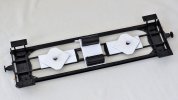
I attached a pair of LGB Jackson Sharp passenger coach bogies to the pivots, using offcuts of plasticard as securing washers. The bogies were fitted with Al Kramer bright nickel plated, turned solid brass wheels, imported from the US. These wheels are standard across all of the Claptowte Railway rolling stock. The wheels are very heavy and give a nice low centre of gravity to the model. I re-attached a brake pipe to each buffer beam. I added bent handrail wire grab handles to each corner of the deck, adjacent to the footsteps. These matched the similar grab handles on the match truck. To complete the rolling chassis, I added a brake wheel to each side of the body. These were from the balcony railings of a LGB Jackson Sharp passenger coach, salvaged from another earlier conversion.

David
To add variety and interest to the Claptowte Railway rolling stock, I had always intended to add a travelling crane, with associated match truck, to support the crane jib while in transit. To that end, over the years, I had collected various donor vehicles and components to construct such vehicles. The crane is based on the LGB Toy Train crane, with an additional Toy Train stake wagon to increase the length of the frame and decking as it was my intention to mount it on a pair of bogies.
Some years ago I acquired a resin casting of a diesel generator, from a trade stand at an exhibition. I believe it to be a copy of a plastic model that was supplied as a wagon load (x3) on a USA Trains flatbed. I thought of using it to use as a wagon load myself until I had the idea of using it as the power source for the travelling crane. The casting itself, was not top quality, being full of blow holes, but used inside the bodywork of a crane, these faults would not be obvious, indeed, most of the time not seen at all.

This is the resin casting of the diesel generator.


This is the starting point of the actual crane conversion, the LGB Toy Train crane body, removed from the stake wagon on which it comes mounted.






I actually began the conversion of this model with the underframe and decking. I took the Toy Train stake wagon on which the crane body had been mounted and added a second stake wagon. Both wagons were dismantled down to their basic components. The stakes, and the two wheel bogies and wheels, on which the wagons had run, were consigned to the spares box. Of the four brake pipes, two were put aside for use on the new body and the other two followed the wheels into the spares box.
In order to create a new longer single body, to mount onto bogies, I used a razor saw to cut midway between the 4th and 5th stake pockets on both bodies, so that when the bodies are brought together, the spacing between the stake pockets, along both sides, are maintained. Be sure to cut off the ‘non balcony’ ends, so that when the underframes are cut to length, to match the decking bodies, the fixing points for the footsteps are retained.

I cut the buffers from the short lengths cut from the underframes. The buffers were kept and consigned to the spares box, the offcuts of decking and frame were discarded.
The two shortened decks were then glued together with a butt joint. The underside of the join was reinforced using a section of 2.0mm plasticard.

I took the underframes and cut off the ‘W’ irons and brake support.

I cut out the various tanks, retaining the large cylindrical tanks and discarding the rest.

I then cleaned up the frames and tanks with files and wet or dry paper.

I then offered up each of the underframes to their respective bodies and cut these to match the body lengths. I glued the two haves together and used plastic strip to strengthen the joints.
Using various suitable thicknesses of plasticard, I built up the underside of the underframes to the appropriate height, finishing off with a large rubbing plate for the bogies. Holes were drilled into which plastic tube was glued to form the pivots for the bogies. LGB Toy Train footsteps were added from the spares box. I attached Garden Railways Supplies (GRS) etched brass lamp irons to each buffer beam. I glued a plasticard plate across the centre of the join between the two donor halves, to further strengthen the join, and glued the pair of salvaged tanks to this.

I attached a pair of LGB Jackson Sharp passenger coach bogies to the pivots, using offcuts of plasticard as securing washers. The bogies were fitted with Al Kramer bright nickel plated, turned solid brass wheels, imported from the US. These wheels are standard across all of the Claptowte Railway rolling stock. The wheels are very heavy and give a nice low centre of gravity to the model. I re-attached a brake pipe to each buffer beam. I added bent handrail wire grab handles to each corner of the deck, adjacent to the footsteps. These matched the similar grab handles on the match truck. To complete the rolling chassis, I added a brake wheel to each side of the body. These were from the balcony railings of a LGB Jackson Sharp passenger coach, salvaged from another earlier conversion.

David
Last edited:

